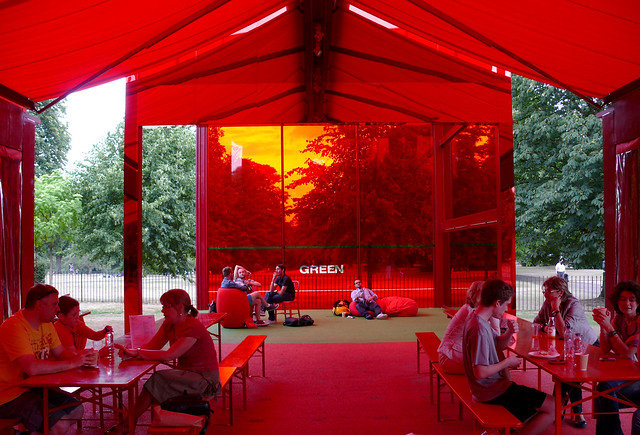By Sarah Wilson
An examination of light manipulation in the Serpentine Gallery Pavilions at Hyde Park
The usage, denial, and manipulation of light is always an
interesting investigation in regards to architecture. Since the year 2000, Hyde
Park of London has hosted a yearly pavilion installation for the Serpentine
Gallery. Each pavilion was temporary, meant to only last six months, but the
attention paid to details of structure and form was not diminished in
comparison to permanent installations. Due to their relationship with the
outdoor park, every pavilion displays consideration towards the effect of
natural light, but this consideration is perhaps best displayed in the
pavilions designed by Toyo Ito in 2002, Sejima and Nishizawa in 2009, and Jean
Nouvel in 2010.
Toyo Ito’s approach to the Serpentine Gallery Pavilion was
mathematical in origin. Utilizing a steel structural frame, Ito worked with an
algorithm developed by co-designer Cecil Balmond. This algorithm described a
cube that expanded as it rotated. After performing this algorithm for six cycles,
Balmond and Ito extended the resulting lines to create a complex pattern of
intersections. Some of these intersections served as primary load bearers while
others were secondary bracers, but altogether, the lines created a coherent
semi-enclosed structure. The manipulation of light came into play when working
with the shapes left behind by the intersecting lines. Many of these triangles
and trapezoids were made solid using concrete, but a nearly equal amount of
shapes were given glass panels. The end result was a box-like structure
punctuated by multiple openings at every side, creating a pattern of light
amongst the visitors inside. This kaleidoscope of geometric light patterns gave
the complex expression of chaos and order as commanded by light and shadow.
SANAA architects Sejima and Nishizawa took a less geometric
approach to their design for the 2009 Serpentine Gallery Pavilion. They
brainstormed several inspirations for form, including a forest, a new horizon,
mountain trees, clouds of smoke, umbrellas, and sprouts. The ending design
combined a few of these inspirations, resulting in an organic shape that flows
and winds about the park. This shape, elevated above the ground on multiple thin
metal columns, was made of a thin layer of polished aluminum. Acting like a mirror, this aluminum form
reflects light almost perfectly, reproducing what the viewer sees depending on
his or her angle. This manipulation of light fashions the new horizon Sejima
and Nishizawa sought to create, and simultaneously provides a sheltered area
for passing, for pausing, and for seeing the park at a different perspective.
Jean Nouvel likewise took a light-focused approach to his
Serpentine Gallery Pavilion in 2010 and, like Ito and Balmond, utilized a
lightweight metal structure to provide his skeleton. Its defining
characteristic, however, is not the use of natural light alone, but the
resulting effect cast within the structure after the light passes through:
everything inside appears to be red. The
thin fabric stretched and draped around the metal structure is dyed red, and the
result is red-tinted light cast on everything and everyone within the pavilion.
The purpose of saturating his pavilion in such bright red was to create a stark
contrast with the bright saturated green of the surrounding park. Nouvel even
goes so far as to print the word “GREEN” in one of the glass walls facing the
exterior. The contrast between the red and green puts greater focus on both,
emphasizing the pavilion while not diminishing its habitat. Like Ito and Sejima
and Nishizawa’s Serpentine Gallery Pavilions, Nouvel’s installation was similar
in that it utilized his materials to manipulate light towards his specific
purpose. Whether it was transparent glass, impermeable concrete, shining
aluminum, or tinted fabric, each of these three pavilions manipulated light to
provide a different perspective on the natural site in which it was placed,
reminding visitors of the habitat in which all architecture was once placed.



No comments:
Post a Comment